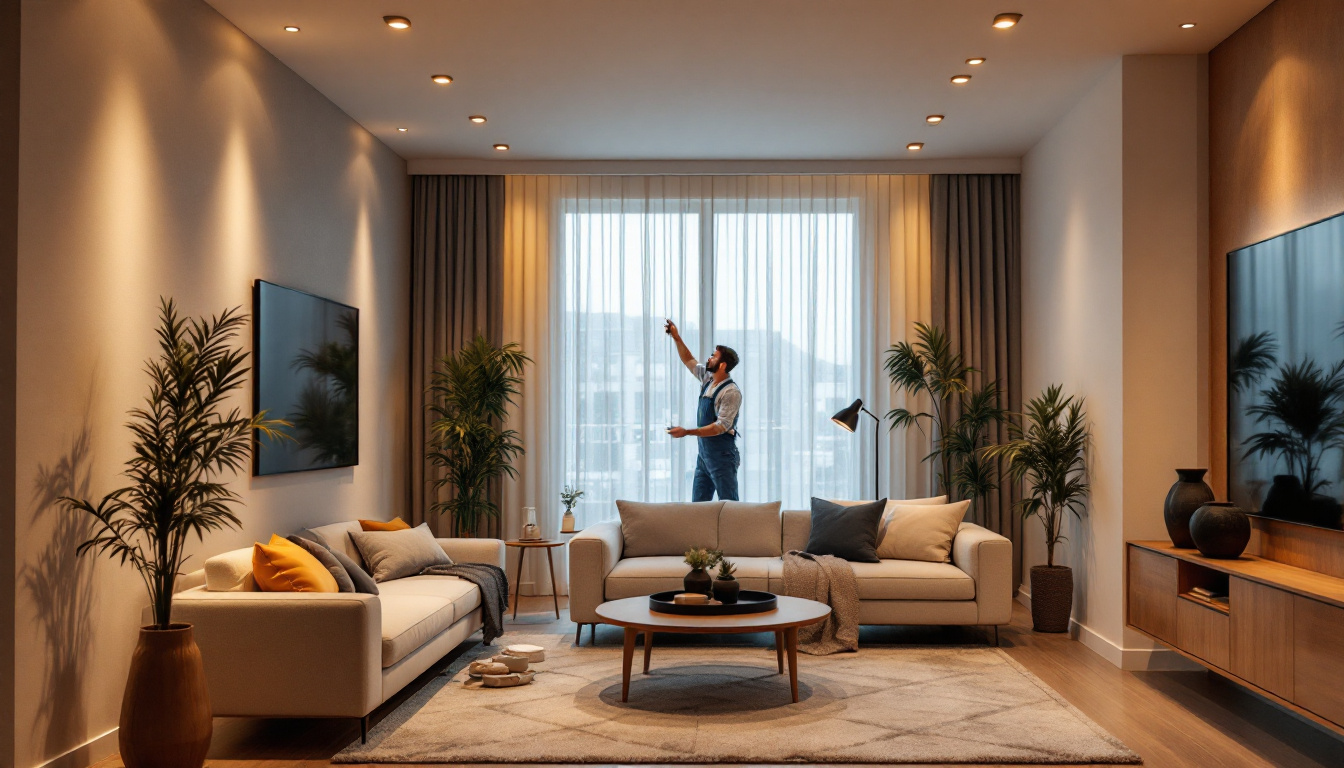

The lighting industry is rapidly evolving, with technology advancing at an unprecedented pace. For lighting contractors, understanding the nuances of light output and brightness is essential for delivering optimal solutions to clients. One of the most critical metrics in this field is the lumen brightness scale. This article delves into the significance of the lumen brightness scale and how it can provide a competitive edge for lighting contractors.
Lumens are a measure of the total amount of visible light emitted by a source. Unlike watts, which measure energy consumption, lumens provide a clear indication of brightness. This distinction is crucial for lighting contractors, as it allows them to recommend appropriate lighting solutions based on the specific needs of their clients.
In practical terms, a higher lumen count indicates a brighter light. For instance, a standard 60-watt incandescent bulb typically emits about 800 lumens, while a 100-watt bulb produces around 1600 lumens. Understanding these figures helps contractors select the right fixtures for various applications, from residential to commercial settings. Additionally, advancements in lighting technology, such as LED and CFL bulbs, have made it possible to achieve higher lumen outputs with significantly lower wattages, further enhancing energy efficiency.
For lighting contractors, the ability to assess lumen output is vital for several reasons. First, it enables them to create well-lit environments that enhance aesthetics and functionality. Proper lighting can significantly impact mood, productivity, and safety in both residential and commercial spaces. For example, in an office setting, adequate lighting can reduce eye strain and improve concentration, while in a retail environment, strategic lighting can highlight products and create an inviting atmosphere for customers.
Moreover, clients are increasingly aware of energy efficiency and sustainability. By choosing fixtures with higher lumen output per watt, contractors can help clients reduce energy consumption while maintaining adequate illumination levels. This not only benefits the environment but also appeals to cost-conscious customers looking to lower their utility bills. Furthermore, the trend towards smart lighting solutions allows for even greater control over lumen output, enabling users to adjust brightness levels according to their specific needs and preferences, thus enhancing the overall user experience.
The lumen brightness scale categorizes light sources based on their lumen output. This scale typically ranges from low lumen outputs, suitable for ambient lighting, to high outputs designed for task-oriented spaces. Understanding this scale allows contractors to make informed decisions when selecting lighting fixtures for different applications.
For example, a cozy living room might require soft lighting around 100-300 lumens per square meter, while a kitchen or workspace may need 500-800 lumens for effective task lighting. By utilizing the lumen brightness scale, contractors can ensure they meet the specific lighting needs of each area, enhancing both functionality and comfort. Additionally, it’s essential to consider the color temperature of the light, measured in Kelvin, as this can significantly influence the perceived brightness and ambiance of a space. Warmer tones (around 2700K-3000K) create a relaxed atmosphere, while cooler tones (4000K-5000K) can invigorate and energize the environment, making them ideal for workspaces.
Different environments have varying lighting requirements, and the lumen brightness scale helps contractors navigate these differences. In residential settings, areas such as bedrooms and living rooms typically benefit from lower lumen outputs, creating a warm and inviting atmosphere. On the other hand, kitchens, garages, and workspaces require higher lumen outputs to facilitate activities that demand clarity and precision.
In commercial applications, the scale becomes even more critical. Retail spaces, for instance, often utilize bright lighting to highlight products and create an engaging shopping experience. Conversely, office environments may require a balance between brightness and comfort to enhance productivity without causing eye strain. Furthermore, the lumen brightness scale is also vital in outdoor lighting applications, where safety and visibility are paramount. Pathways, parking lots, and security lighting often need higher lumen outputs to ensure that areas are well-lit and safe for navigation, especially during nighttime. The correct application of the scale can significantly impact both the aesthetic and functional aspects of outdoor spaces, contributing to a sense of security and well-being for users.
One of the primary advantages of utilizing the lumen brightness scale is the ability to enhance client satisfaction. By accurately assessing and recommending appropriate lighting solutions, contractors can meet and exceed client expectations. This not only fosters trust but also encourages repeat business and referrals.
When clients are pleased with the lighting solutions provided, they are more likely to share their positive experiences with others. This word-of-mouth marketing is invaluable in the competitive lighting industry, where reputation can significantly influence success.
Energy efficiency is a growing concern for many clients, particularly in commercial settings where lighting costs can be substantial. By leveraging the lumen brightness scale, contractors can recommend fixtures that provide maximum brightness with minimal energy consumption. This not only helps clients save money but also aligns with sustainability goals.
Incorporating energy-efficient lighting solutions can also qualify clients for various incentives and rebates, further enhancing the appeal of these recommendations. Contractors who prioritize energy efficiency will find themselves in high demand as clients increasingly seek environmentally friendly options.
Before implementing the lumen brightness scale in a project, it is essential to assess the specific needs of the client. This involves understanding the intended use of each space and the desired ambiance. For instance, a client may prefer warm lighting for a cozy living room but require bright, cool lighting for a home office.
Conducting a thorough assessment allows contractors to tailor their recommendations effectively. Engaging in discussions with clients about their preferences and expectations can lead to better outcomes and a more collaborative approach to the project.
Once the client’s needs are established, selecting the appropriate fixtures becomes paramount. The lumen brightness scale serves as a guide to determine which products will provide the desired illumination levels. Contractors should consider factors such as fixture type, placement, and the overall design of the space.
Additionally, it is essential to stay updated on the latest lighting technologies and products. Advances in LED technology, for example, have revolutionized the industry, offering higher lumen outputs with lower energy consumption. By staying informed, contractors can provide clients with the most efficient and effective solutions available.
While the lumen brightness scale is a valuable tool, misinterpretation can lead to suboptimal lighting solutions. Some contractors may confuse lumens with other metrics, such as lux or foot-candles, which measure illuminance rather than total light output. This confusion can result in inadequate lighting that fails to meet client expectations.
To mitigate this challenge, contractors should invest time in education and training. Understanding the differences between various lighting metrics and how they apply to specific projects is crucial for delivering high-quality results.
Every client has unique preferences and expectations regarding lighting. Some may prioritize aesthetics over functionality, while others may have specific energy efficiency goals. Balancing these diverse needs while adhering to the lumen brightness scale can be challenging.
Effective communication is key to overcoming this challenge. By discussing options and providing clear explanations of how different choices impact lighting quality and energy consumption, contractors can guide clients toward informed decisions that align with their priorities.
The future of lighting is increasingly leaning toward smart technology. Smart lighting solutions allow for greater control over brightness levels, color temperature, and energy consumption. As these technologies become more prevalent, understanding the lumen brightness scale will remain essential for contractors.
Smart lighting systems often come equipped with features that enable users to adjust brightness based on specific activities or preferences. Contractors who are knowledgeable about the lumen brightness scale can help clients select the right smart fixtures that meet their unique lighting needs.
As the focus on sustainability continues to grow, lighting contractors will need to prioritize energy-efficient solutions. The lumen brightness scale will play a crucial role in this transition, as it allows contractors to recommend products that provide optimal brightness while minimizing energy consumption.
Clients are increasingly seeking out environmentally friendly options, and contractors who can effectively communicate the benefits of energy-efficient lighting will have a competitive advantage in the marketplace. By aligning with sustainability goals, contractors can position themselves as leaders in the industry.
The lumen brightness scale is an invaluable tool for lighting contractors, providing insights that can enhance client satisfaction, improve energy efficiency, and streamline project implementation. By understanding and effectively utilizing this scale, contractors can differentiate themselves in a competitive market.
As the lighting industry continues to evolve, staying informed about trends and advancements will be crucial. Embracing new technologies and prioritizing sustainability will further enhance the contractor’s ability to meet client needs and expectations.
Ultimately, the lumen brightness scale is more than just a measurement; it is a pathway to delivering exceptional lighting solutions that elevate spaces and enhance the quality of life for clients. By leveraging this knowledge, lighting contractors can ensure their success in an ever-changing industry.
Ready to elevate your lighting projects with the lumen brightness scale and the finest products on the market? Look no further than LumenWholesale, where we provide contractors with top-tier, spec-grade lighting solutions at unbeatable wholesale prices. With our commitment to quality, affordability, and convenience, you’ll find everything you need to outshine the competition. Say goodbye to inflated markups and hello to hassle-free bulk buying with free shipping. Don’t compromise on your lighting needs—choose LumenWholesale for Wholesale Lighting at the Best Value and give your clients the exceptional lighting they deserve.

Discover the essential insights lighting contractors need to know about sconces.

Discover how industrial warehouse lighting fixtures are transforming spaces with real-world success stories.

Discover the essential role of parking lights in urban planning and safety.

Discover the cost dynamics of recessed lighting and how it enhances efficiency for lighting contractors.
Get notified when NEW deals are released.
Optimize your budget with wholesale discounts.
Only top-quality, specification-grade lighting products.
No additional costs at checkout - what you see is what you pay.
We understand the unique needs of contractors.